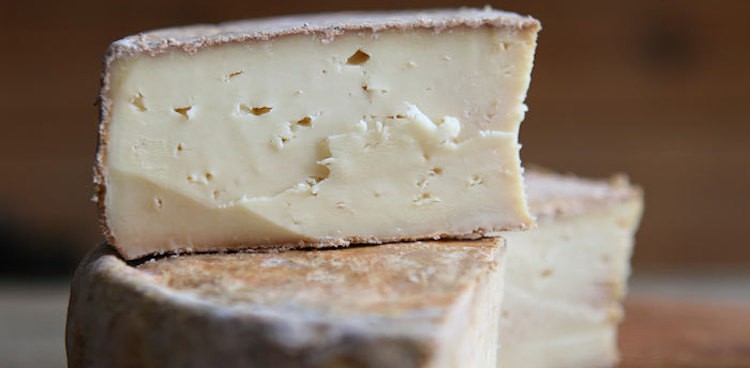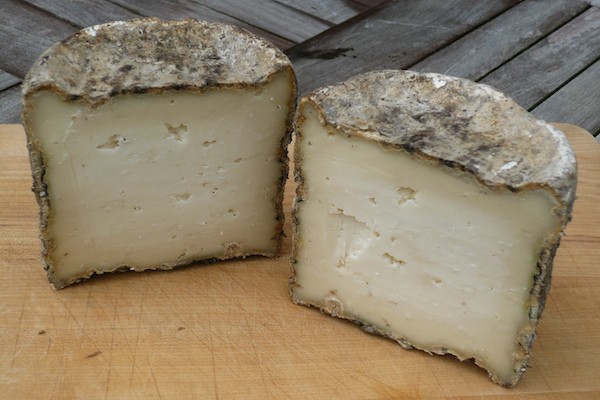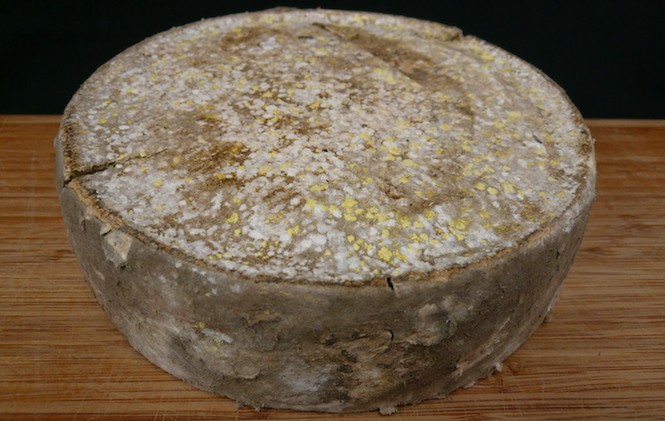
A tome, toma, or tomme is a kind of petite, round cheese made on the same farm from which its milk is sourced. French cheese lovers tend to associate tomme-style cheese with its circular round shape, earthy gray-brown rind, and intensely nutty taste. Despite all the similarities, there’s tons of variety when it comes to the type of milk and the overall flavor profile of the cheeses that fall under the umbrella of tomme. Though these cheeses are a classic French invention, American production has spread the claim to all kinds of tommes: semi-soft, hard, washed, natural rind… and the list grows alongside new recipes and methods. So with all this variety, what makes a tomme a tomme?
Tomme Sweet Tomme
There are two distinctive features of tomme production. The first is that the milk is heated to a lower temperature than in most other cheesemaking, only to about 88 to 99°F. Secondly, the curds are pressed into signature wheel-shaped molds, either by hand or by weights. (Tome means “wheel” or “round” in French.) The lower heat and shaping create the “tomme” texture that, though it can range in density and intensity, is always fairly velvety on the palate.

Like many tomes, this Twig Farm cheese has a distinctive dark and mottled rind.
In addition to a common texture, each tomme has a dank, earthy rind—sometimes it evens looks as if the cheese has been dropped in dirt or fuzz. But though it can be as weathered-looking as a Nick Nolte–Mickey Rourke lovechild, don’t fear the tomme. Its seasoned appearance is due to the aging process, which can range upwards of seven weeks. The microflora in cave-aging create the earthy rind. Another tell-tale sign of tomme-iness is aroma. Tommes possess a scent not unlike the caves they are aged in: Rustic, earthy, and loamy.
The taste of tomme cheeses can vary wildly, with notes ranging from rich hazelnut to mildly grassy. The differences in flavor are due largely to the difference in milk sources. Cheese gets its flavor from fat/protein breakdown, bacteria, and the animals from which it’s created. Often, we can even taste what the animals have been eating through the cheese they make—grass, for instance, or hay or flowers.
Tomme Home
Tomme de Savoie is a skimmed cow’s milk cheese that comes in many varieties throughout the Savoie, a small French region bordering both Italy and Switzerland. Tommes produced here are right at home: It is believed that they originated in these alpine regions as a way for cheesemakers to use up leftover skimmed milk from other cheesemaking productions. Tommes take less time to age than other alpine cheeses, so cheesemakers used them to make a little extra money or to feed their families in leaner months. Tomme de Savoie is a mild, semi-soft cow’s milk cheese with clean flavors of citrus, mushroom, and cellar. Its suede-like, gray/tan rind is mottled with different natural molds of varying color, and inside is an ivory paste with small eyes.
Wheels of Greatness
Tomme de Manigodine has a thick, pale orange rind dusted with a thin layer of white mold. Medium-sized eyes nearer to the edges of the cheese give way to a dense, yellowed paste at the core. This milky, nutty cheese is amazing in Tartiflette, a bacon-studded potato gratin.

Tommette de Corbiers has an unique hexagonal shape.
Toma Piemontese is produced in the alpine region of Piedmont, Italy. It is made with whole or skimmed cow’s milk, is semi-soft to firm, and has a nutty, earthy flavor somewhat similar to its aged alpine cousins. It is the only PDO cheese which concerns the entire regional territory, since the milk source, processing, and affinage occur across many provinces.
Tommette de Corbiers is a petite, hexagonal raw sheep’s milk cheese that is produced in limited portions in southern France. During the 60-day aging process, cheeses are bathed in a saltwater brine and sprayed with Grenache, a strong, amber-colored local wine. The interior paste is ivory in color, darkening as it approaches the toothsome orange rind. The tommette’s mushroomy flavors are enlivened with notes of caramel and honey.
Pick a Partner
- Cheesemonger Gillian Marino has a tasty pairing in mind. She says, “Tomme de Crayeuse is one of my favorites, and I’ve been pairing it with a loose greengage plum chutney that is just the plums and a bit of sugar. It’s nicely tart to match the buttery flavor and cakey texture of the Tomme Crayeuse.”
- Lightly panfry a rich, oozy Tomme Vaudoise and serve on a chewy baguette with prosciutto and spicy greens
- Pan-Roasted Mushrooms over Cheesy Polenta is a great use for tomme-style cheeses

The most well-known tomme: Tomme de Savoie.




We made Tome cheese and it is glorious. Thanks for the ideas.
Thank you for this article. It was extremely detailed and answered all the questions I had about this type of cheese. .
Loved the article! I was not aware of this type of cheese, no I promise I don’t live under a rock, haha!! Anyway, just wanted to thank you for sharing! Tomorrow I will be in search of Tomme cheese, I cannot wait to try it!!